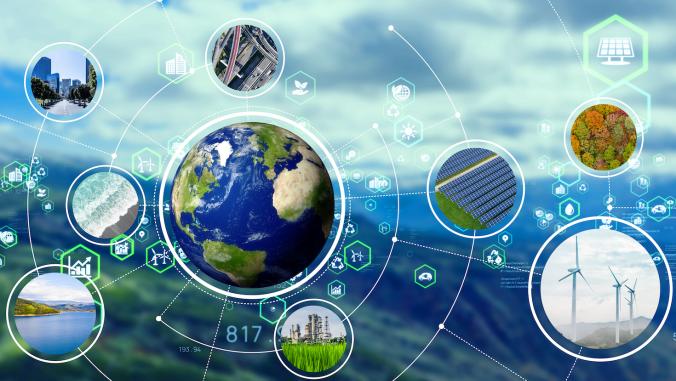The climate action game: How will you play?
Climate rehabilitation is a critical move in this strategic game.

There are many potential moves to make. What's yours?
This is fifth in a series on the role of public-private collaboration in realizing smart, sustainable cities, systems and industries.
As outlined in colorful detail during September’s Global Climate Action Summit (GCAS) in San Francisco, the climate change challenge is upon us, and the call for collective action has grown increasingly urgent. In this and future articles, we share findings from the summit and beyond that can help you find your company’s way to play in the massively multi-player game of climate action.
Climate action matters
Climate-related disruptions to the cities and systems in which you operate will in turn disrupt your business — whether sooner or later, directly or indirectly, acutely or chronically. Your workforce, supply chain, product, customers and bottom line may be affected in big and small ways. Make no mistake — climate action matters to your business.
With only two years to secure a path to relative climate security, uncertainty about priorities is quickly dissolving. Savvy businesses will take internal action and partner with cities and others to contain and adapt to the effects of climate change.
Surprising benefits of climate action
In events surrounding GCAS, the C40 Cities Climate Leadership Group, in collaboration with the Global Covenant of Mayors for Climate & Energy and the New Climate Institute, issued a new Carbon Opportunity report, describing how climate action leads to diverse socio-economic impacts such as more jobs, better health and livable cities. The report (PDF) estimated, "By 2030, a boost in urban climate action can prevent approximately 1.3 million premature deaths per year, net generate 13.7 million jobs in cities and save 40 billion hours of commuters’ time plus billions of dollars in reduced household expenses each year."
At the same time, C40 released a new framework (PDF) — developed in collaboration with Danish engineering firm Ramboll — which they used to assess and articulate those diverse impacts of climate action. The Urban Climate Action Impacts Framework (UCAIF or "the Framework") "functions as a user guide with common principles, taxonomy and guidelines for approaching the mapping and assessment of those wider impacts."
I found the Framework to offer a simple and powerful way to identify and express diverse value generation across the sustainability domains sometimes known as the triple bottom line. The framework may be useful in helping your business think about, articulate, justify and energize around the potential impact of your own climate action.
Act one: climate rehab
Cimate action begins with climate rehabilitation — or shoring up the climate-producing elements of our planet. According to this "Nova" documentary I enjoyed, climate is the interaction of four components — atmosphere, oceans, ice and earth. Rehabilitating any of them can improve our current and future climate conditions.
Atmosphere: Super pollutants may be contributing as much as 50 percent to the current warming trends of the planet. These relatively short-lived but super-potent substances include methane, refrigeration HFCs and black carbon "soot." If we can mitigate these, we can stop the bleeding for our injured atmosphere. So if your business is a heavy user of natural gas, refrigeration or diesel vehicles, you may need to reduce reliance and prevent leaks. If you are in the agriculture or oil and gas business, you may need to engage in methane abatement. And if you are in the air conditioning or refrigeration business, you may want to join the Air Conditioning, Heating and Refrigeration Institute (AHRI) to help support the phase-out of HFCs.
Oceans: The oceans are absorbing one-third of the greenhouse gases (GhGs) humans are emitting. Without their help, the earth’s temperature already would be much higher. But this role results in heightened ocean acidity, at the expense of fisheries and marine ecosystems. The International Alliance to Combat Ocean Acidification (OA Alliance) brings together governments and organizations at all stages of learning to combat ocean acidification and changing ocean conditions. Your business may wish to join as an affiliate member in order to elevate the issue and advance the work. Meanwhile, the Sustainable Oceans Alliance (SOA) advances the impact of start-ups, social enterprises and youth-centered initiatives that are developing solutions to protect and sustain our oceans. You may wish to become a partner or sponsor of SOA.
Ice: As former Vice President Al Gore, founder of the Climate Reality Project, explained to GCAS audiences, melting ice in the Arctic has affected the jet stream — causing it to be "loopier, wavier" and not moving weather systems along quickly. This causes storms to hover in place, wreaking havoc for days. For this and other reasons, it is critical that the Arctic ice melt be slowed. To that end, the non-profit Ice911 has developed a "soft" geoengineering solution to help preserve Arctic ice, which acts as a global heat shield. After extensive field testing, it now has "the technology, the team, and the experience needed to [help] stabilize the climate… buying us more time to adopt sustainable solutions." Consider becoming a climate champion by supporting the boots-on-the-ground rehabilitation of our ice systems.
Earth: Protecting and restoring forests, producing food more sustainably and improving land use are natural climate solutions that are affordable, scalable and available. According to the Forgotten Solution, they can "deliver 30 percent of the climate solution needed by 2030, but are less than 1 percent of the conversation." If land use is a leverage point for your business, your potential role is outlined here. The 30X30 Forests, Food and Land Challenge has a similar goal; its details are outlined here.
Meanwhile, Cities4Forests works on behalf of "inner," "nearby" and "faraway" forests. Its goal is to "amplify current best practices and extend the deliberate city-forest relationship." Forty-five cities are founders; see if your potential city partner is on the list.
Act two: crafting your climate plan
Once your strategies for "climate rehab" are underway, it will be time to craft a Climate Action Plan for your business, in collaboration and coordination with your city and its priorities. A climate action plan lays out a multi-faceted strategy to address climate change and reduce greenhouse gas emissions.
In the next several articles, we will point you toward city partnership, and outline a menu of action options to consider adding to your plan. Until then, check out the video Paris to Pittsburgh unveiled at GCAS, to be aired on the National Geographic channel in December, and be inspired for the game — and the journey — ahead.





